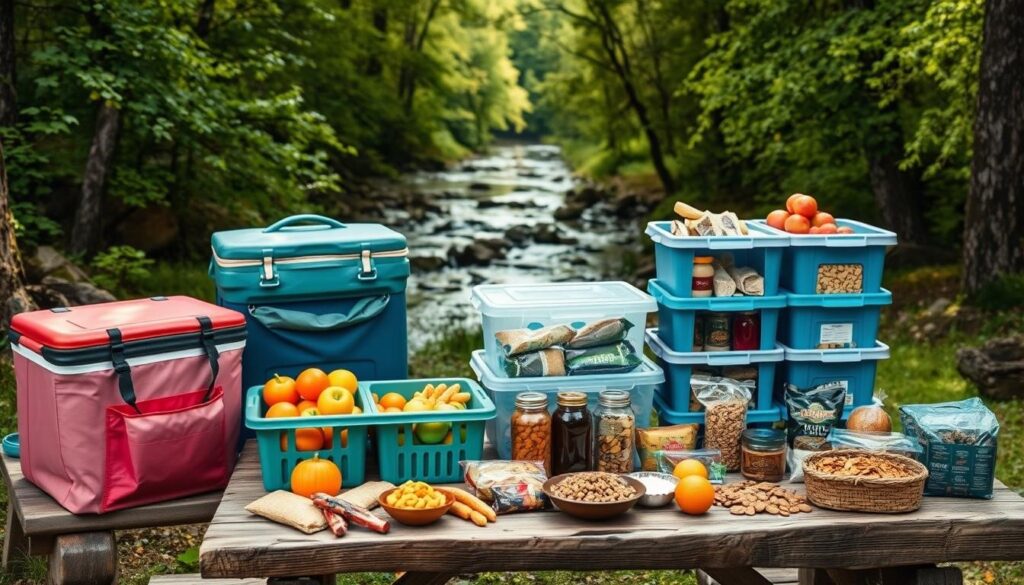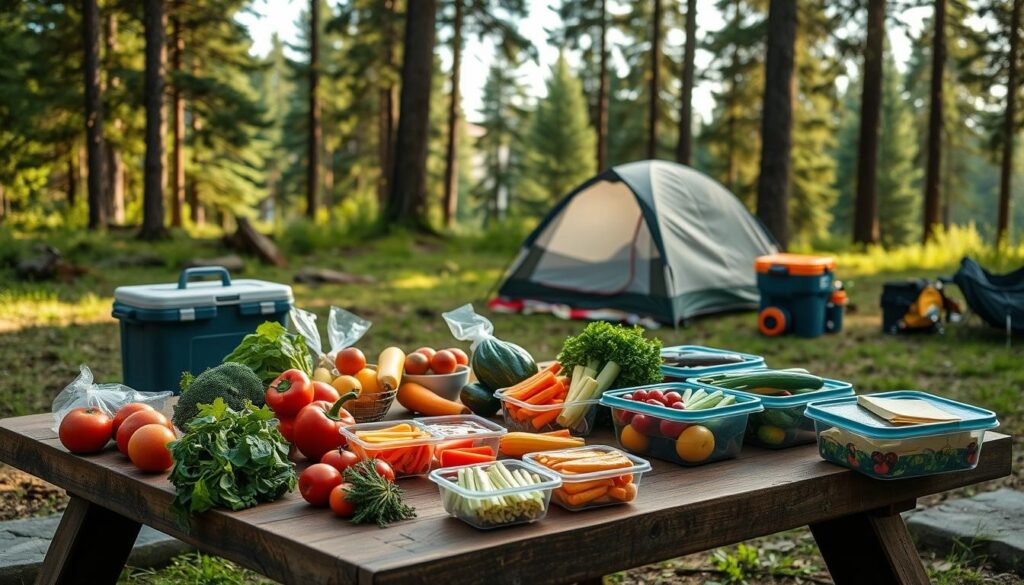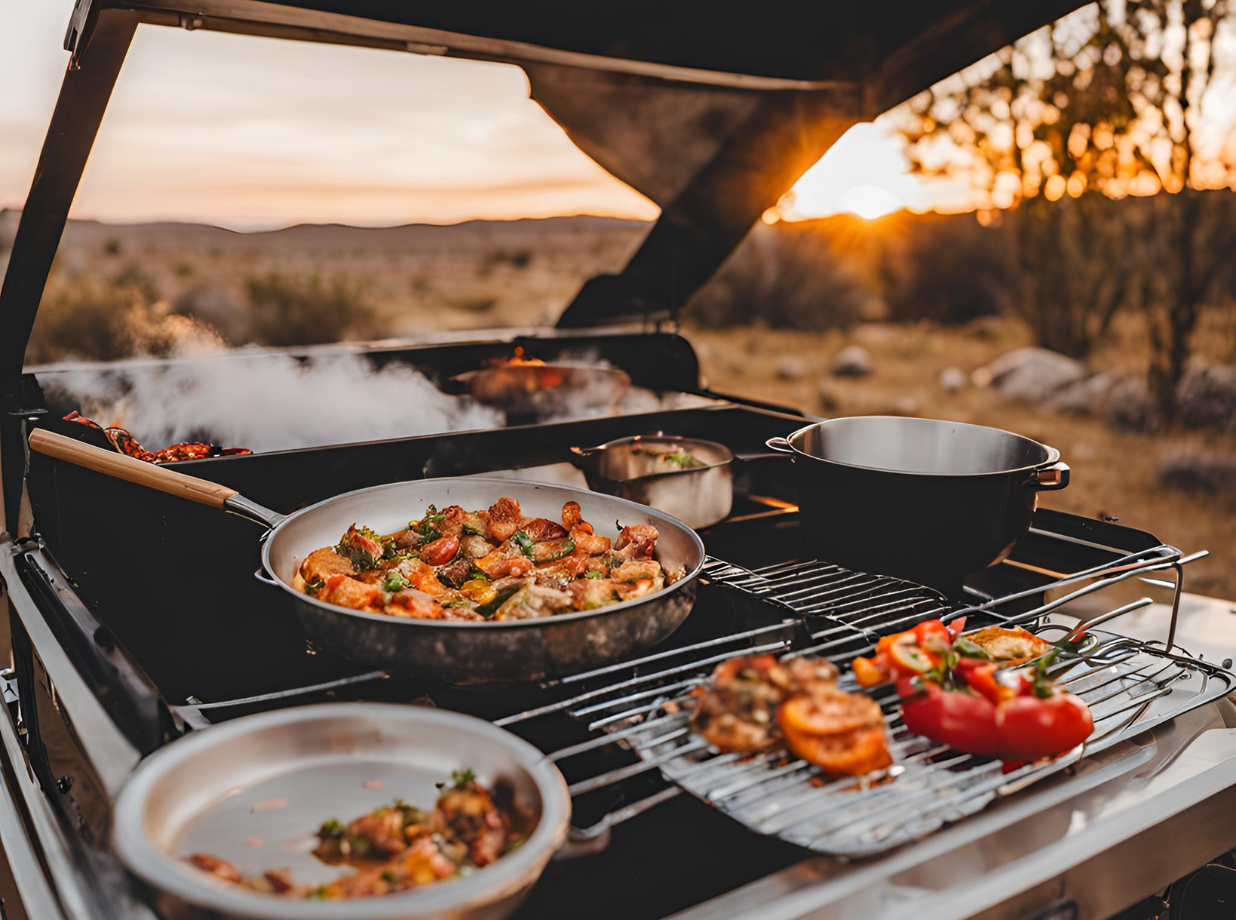Going camping means enjoying nature and tasty meals. But, keeping your food fresh and safe can be tough. This guide will give you key tips to keep your food good during your trip.
Ever thought how campers keep their food fresh in wild places? What secrets do they use to keep their meals tasty and healthy?

“An organized camping setup showcasing various food storage solutions, including a cooler filled with ice, airtight containers storing grains and snacks, a hanging mesh organizer with fresh fruits, and durable, eco-friendly bags for dry goods, surrounded by lush greenery and a scenic campsite backdrop.”
Key Takeaways
- Discover essential gear and techniques for preserving food while camping
- Learn how to maintain ideal temperature conditions to keep your provisions fresh
- Explore strategies for extending the shelf life of both perishable and non-perishable food items
- Uncover creative hacks to combat food spoilage and maximize your camping food supplies
- Explore alternative refrigeration options for longer camping trips
The Importance of Proper Food Storage while Camping
When camping, keeping your food fresh is key. The outdoors can be tough on food, making it important to store it right. Let’s see why it’s crucial to keep your food fresh and the risks of eating spoiled food on your trip.
Why Keeping Food Fresh Matters in the Great Outdoors
Camping takes us away from modern kitchens and refrigerators. The changing temperatures and wildlife can quickly ruin your food. Storing your food right keeps it tasty, nutritious, and safe for eating outdoors.
Potential Health Risks of Consuming Spoiled Food
Eating spoiled food can be dangerous. Bacteria like Salmonella and E. coli can grow in bad food, causing sickness. This can make your trip worse and might even need a doctor’s help. So, make sure to store your food right to stay healthy.
“Proper food storage is the key to a successful and enjoyable camping trip. Keeping your food fresh and safe should be a top priority.”
Knowing how important proper food storage is helps keep your camping trip safe and fun. Next, we’ll give you tips on camping food storage, preserving food while camping, and preventing food spoilage while camping.
How to Keep Food Fresh When Camping
Keeping your food fresh while camping is key for fun and safety. Having the right gear and techniques is crucial. Let’s explore the must-have equipment and methods for keeping your food tasty on your outdoor trip.
Essential Gear for Food Preservation
Choosing the right gear is the first step in keeping food fresh. A top-notch cooler is a must, as it helps control temperature and protect your food. Look for coolers with strong insulation and a solid build for the best results.
Reusable ice packs or blocks are also vital. They keep your cooler at a steady cold temperature. Don’t forget an airtight food storage container. These keep your food safe from the elements and keep it fresh.
Maintaining Ideal Temperature Conditions
It’s important to keep your food at the right temperature to avoid spoilage. Pack your cooler smartly to ensure everything cools evenly. Put things you’ll use often at the top and the rest deeper down.
For longer trips, think about using portable camping fridges or freeze-dried meals. These options can keep your food fresh for longer, so you can enjoy tasty meals all trip long.
“The key to keeping your camping food fresh is a combination of the right gear and careful temperature management. With these strategies, you can savor every bite and focus on creating unforgettable memories in the great outdoors.”
Camping Food Storage Tips for Perishable Items
Keeping food like meats, dairy, and produce fresh while camping can be tough. But, with the right strategies, your food can stay safe and tasty. Here are some camping food storage tips to keep your food fresh and extend its shelf life.
Proper Insulation and Temperature Control
Keeping the right temperature is key for storing perishable items. Use a high-quality cooler and fill it with ice. Make sure to rotate the ice often and consider using frozen water bottles or reusable ice packs for extra insulation.
Strategic Food Placement
Place your perishable items in the cooler wisely. Put raw meats and seafood at the bottom, under produce and dairy. This stops cross-contamination and keeps the coldest air around the most sensitive foods.
Airtight Packaging
Get resealable bags, airtight containers, or vacuum-sealed pouches for your perishable items. These keep air out and help keep food fresh for longer.
Rotate and Consume Quickly
Use the oldest items first and eat them within a day or two. Don’t leave perishable foods out too long, and watch the expiration dates.
By using these camping food storage tips, you can preserve your perishable items and extend the shelf life of your camping food. This ensures a safe and tasty outdoor trip.
Preserving Non-Perishable Foods During Your Camping Trip
While meats and dairy need refrigeration, many non-perishable foods can last long on your camping trip. With the right methods, you can keep your food fresh and safe. This is true whether you’re going for a weekend or a long wilderness trip.
Proper Packaging and Sealing Techniques
Keeping your camping food storage tips fresh starts with good packaging and sealing. Use strong, airtight containers like screw-top jars, resealable bags, or vacuum-sealed pouches. These keep freshness in and keep outdoor dirt out. Always remove air from containers to stop food from spoiling.
- Invest in high-quality, resealable food storage bags or containers
- Squeeze out excess air before sealing to create an airtight seal
- Label and date all packaged items for easy tracking of lasting food supplies for camping trips
Using the right camping meal prep and preservation methods keeps your non-perishable foods fresh. This way, they’re ready to eat during your camping trip.

A serene camping scene depicting a variety of non-perishable food storage methods, including vibrant canvas coolers filled with colorful fruits and vegetables, sturdy plastic bins organized with neatly labeled jars and packages, a rustic wooden picnic table displaying an assortment of dried goods and snacks, surrounded by lush green trees and a gentle stream in the background, evoking a sense of freshness and outdoor adventure.
“The key to lasting food supplies for your camping trips is all in the prep work. Proper packaging and sealing techniques can make a world of difference in keeping your non-perishable items fresh and ready to enjoy.”
Mastering the Art of Cooler Management
Managing your camping cooler well is key to keeping your food fresh and safe outdoors. By using ice wisely and keeping things insulated, you can make your food last longer. This way, your food stays cool and ready to eat.
Optimizing Ice Usage and Insulation
For camping cooler management, finding the right ice and insulation balance is crucial. Begin by chilling your cooler before you leave. Then, fill it with enough ice to keep things cool. Using more ice means your food stays cooler longer. But, too much ice adds weight and takes up space, so aim for the right amount.
Insulation is also vital for keeping your cooler cold. Choose a top-quality cooler made for camping refrigeration alternatives. Don’t open your cooler too often, and think about using a separate “day cooler” for things you use a lot. This helps keep the cold in and the heat out.
Learning how to manage your cooler right means your camping food stays fresh and safe. With these tips, you can enjoy tasty and healthy meals on your camping trip. You’ll be able to eat well, no matter how long you’re outdoors.
Preventing Food Spoilage with Proper Meal Planning
Keeping your camping food fresh is key for a great outdoor trip. Plan your meals well to avoid food spoilage. This way, you can reduce food waste and have enough supplies for your camping trips.
For camping food storage tips, start by listing the meals you’ll need. Think about how many people are coming and what you’ll do. This helps you pack the right amount of each ingredient, so you don’t pack too much or run out.
- Choose non-perishable foods: Canned goods, dehydrated meals, and packaged snacks are great for lasting food supplies for camping trips. They last longer and don’t spoil easily outdoors.
- Use the same ingredients in different meals: This way, you use more of your supplies and waste less food.
- Control your portions: Measure and pack just the right amount of each ingredient. Don’t bring too much, as it might spoil.
Good camping meal prep and preservation also keeps food fresh. Use airtight containers, resealable bags, and other storage to protect your food from the outdoors.
| Meal Planning Tip | Benefit |
|---|---|
| Prioritize non-perishable foods | Reduces risk of food spoilage |
| Plan meals with shared ingredients | Maximizes use of supplies and minimizes waste |
| Practice portion control | Prevents over-packing and ensures optimal freshness |
Use these camping food storage tips when planning your trip. You’ll have a stress-free outdoor adventure with tasty, fresh meals.

A serene campsite scene featuring a well-organized picnic table with colorful, fresh ingredients for meal prep, including vegetables, fruits, and neatly packed containers. In the background, a tent nestled among tall pine trees, with a cooler and cooking gear nearby. Natural lighting highlighting the vibrant colors of the food and the peaceful outdoor atmosphere, creating a sense of freshness and adventure.
Extending the Shelf Life of Your Camping Food Supplies
Going camping means you need fresh, tasty food. But keeping your food fresh outside can be tough. Don’t worry, I’ve got some clever tips to keep your camping food fresh and tasty. These tips will make sure you have plenty of food for your trip.
Savvy Storage Solutions
Keeping your camping food fresh starts with good storage. Use top-notch, airtight containers to protect your food from the outdoors. Vacuum-sealed bags are great for keeping things like meats and cheeses fresh. Also, use reusable silicone bags to help prevent food from going bad.
Freeze-Ahead Favorites
Freeze some of your favorite meals before you go camping. Soups, stews, and casseroles freeze well and can be reheated easily. Just remember to use strong, insulated containers to keep them cold.
| Camping Food Freshness Hacks | Benefits |
|---|---|
| Airtight Containers | Protect food from the elements and prevent spoilage |
| Vacuum-Sealed Bags | Preserve the freshness of perishable items like meats and produce |
| Reusable Silicone Bags | Minimize the risk of food spoilage and reduce waste |
| Freeze-Ahead Meals | Provide quick, nutritious options that stay fresh for days |
Using these camping food freshness hacks will help you enjoy lasting food supplies for camping trips. With a bit of planning and creativity, you can extend the shelf life of your camping food. This way, you can enjoy your outdoor adventure without worrying about your food going bad.
Camping Refrigeration Alternatives for Longer Trips
For longer camping trips, traditional coolers might not keep your food fresh. Luckily, there are other ways to keep your food at the right temperature. These options can help you keep your food fresh during longer outdoor trips.
A portable camping fridge is a great choice. These small, energy-saving units can plug into your car or run on batteries. This means your food and drinks stay cold even on long trips. Solar-powered refrigeration systems are also a good choice. They use the sun’s energy to cool your food without using fossil fuels.
You can also look into insulated food storage containers made for camping. These coolers have better insulation and features like ice packs or thermoelectric cooling. This lets you keep your food fresh for a longer time than regular coolers. Using these alternatives with good cooler management and meal planning can help you keep your camping food fresh. This way, you can enjoy a worry-free outdoor trip.
Frequently Asked Questions
Why is proper food storage important when camping?
Keeping food fresh and safe while camping is key. The outdoors can quickly spoil your food due to changing temperatures and humidity. This can lead to serious health issues if you eat spoiled food.
What are the potential health risks of consuming spoiled food while camping?
Eating spoiled food can make you very sick. Symptoms include nausea, vomiting, diarrhea, and stomach cramps. These can be bad news in the wilderness, where getting medical help is hard.
What are some essential gear and equipment for keeping food fresh when camping?
You’ll need a good cooler, insulation, and devices to check the temperature. Keeping your cooler closed often helps keep food fresh.
How can I keep perishable items like meats, dairy, and produce fresh while camping?
Keep perishables in the coolest part of your cooler. Don’t let them sit out too long. Use containers or bags that seal well to keep them fresh.
What techniques can I use to preserve non-perishable foods during my camping trip?
Use airtight containers and vacuum-seal non-perishables. Store them in a cool, dry spot at your campsite. Keep them away from sunlight and high heat.
How can I optimize my cooler’s performance to keep food fresh for longer?
Make your cooler work better by packing it right and opening it less. Use ice or reusable packs and keep it insulated. This keeps your food at the right temperature.
How can meal planning help prevent food spoilage during my camping trip?
Plan your meals carefully to avoid food waste. Pack only what you need and use containers that seal well. Eat the perishable items first to keep them fresh.
What are some creative hacks for extending the shelf life of my camping food supplies?
Try using frozen water bottles as ice, or store food in insulated containers. Pre-portion your food and look into portable fridges or solar options for longer trips.
What are some reliable refrigeration alternatives for extended camping trips?
For longer trips, coolers might not be enough. Look into portable fridges or solar-powered options. These can keep your food fresh for longer.

